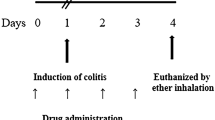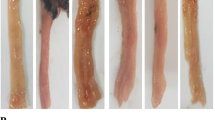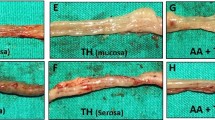Abstract
Inflammatory bowel disease composed of ulcerative colitis and Crohn’s disease is a disorder that may involve entire gastrointestinal tract. Its pathogenesis is mainly an immune-mediated inflammation. Recently, it has been indicated that bupropion possesses anti-inflammatory properties; hence, the objective of this experiment is the investigation of the anti-inflammatory influence of bupropion on colonic lesions that emerged following the intrarectal administration of acetic acid. Thirty-six male Wistar rats were allocated randomly into six groups, including control, acetic acid, dexamethasone (2 mg/kg), and bupropion (40, 80, and 160 mg/kg). Colitis was induced by intrarectal administration of acetic acid in all study groups except control group, and animals were treated by oral administration of dexamethasone and bupropion. While macroscopic and microscopic lesions were observed after colitis induction, administration of dexamethasone and bupropion 160 mg/kg led to the remarkable improvement in lesions. In addition, the expression of TLR4 and NF-ĸB was decreased after colitis induction; however, treatment with dexamethasone (2 mg/kg) and bupropion (160 mg/kg) resulted in a significant decrease in their expression. Regarding biochemical factors, following colitis induction, TNF-α level and MPO activity were increased; nevertheless, dexamethasone (2 mg/kg) and bupropion (160 mg/kg) decreased the TNF-α and MPO activity. In conclusion, bupropion exerts anti-inflammatory influence through suppressing the TLR4 and NF-ĸB expression in the rat model of acute colitis.






Similar content being viewed by others
References
Hanauer, Stephen B. 2006. Inflammatory bowel disease: Epidemiology, pathogenesis, and therapeutic opportunities. Inflammatory bowel diseases 12 (suppl_1): S3–S9.
Levine, Arie, Anne Griffiths, James Markowitz, David C. Wilson, Dan Turner, Richard K. Russell, John Fell, Frank M. Ruemmele, Thomas Walters, and Mary Sherlock. 2011. Pediatric modification of the Montreal classification for inflammatory bowel disease: The Paris classification. Inflammatory Bowel Diseases 17 (6): 1314–1321.
Monteleone, Giovanni, Francesco Pallone, and Thomas T. MacDonald. 2011. Emerging immunological targets in inflammatory bowel disease. Current Opinion in Pharmacology 11 (6): 640–645.
Rakoff-Nahoum, Seth, Justin Paglino, Fatima Eslami-Varzaneh, Stephen Edberg, and Ruslan Medzhitov. 2004. Recognition of commensal microflora by toll-like receptors is required for intestinal homeostasis. Cell 118 (2): 229–241.
Ohkawara, Tatsuya, Hiroshi Takeda, Kencho Miyashita, Morie Nishiwaki, Toshinori Nakayama, Masaru Taniguchi, Takashi Yoshiki, Junji Takana, Masahiro Imamura, and Toshiro Sugiyama. 2006. Regulation of Toll-like receptor 4 expression in mouse colon by macrophage migration inhibitory factor. Histochemistry and Cell Biology 125 (5): 575–582.
Aderem, Alan. 2001. Role of Toll-like receptors in inflammatory response in macrophages. Critical Care Medicine 29 (7): S16–S18.
Li, Ming-Cai, and Shao-Heng He. 2004. IL-10 and its related cytokines for treatment of inflammatory bowel disease. World Journal of Gastroenterology 10 (5): 620–625.
Lin, Sen, Qing Yin, Qi Zhong, Feng-Lin Lv, Zhou Yu, Jing-Qi Li, Jing-Zhou Wang, Su Bing-yin, and Qing-Wu Yang. 2012. Heme activates TLR4-mediated inflammatory injury via MyD88/TRIF signaling pathway in intracerebral hemorrhage. Journal of Neuroinflammation 9 (1): 46.
Ke, Xiao, Fan Zhou, Youliang Gao, Bingying Xie, Guanghong Hu, Wenyi Fang, Jun Peng, Youqin Chen, and Thomas J. Sferra. 2013. Qing Hua Chang Yin exerts therapeutic effects against ulcerative colitis through the inhibition of the TLR4/NF-κB pathway. International Journal of Molecular Medicine 32 (4): 926–930.
Baumgart, Daniel C., and William J. Sandborn. 2007. Inflammatory bowel disease: Clinical aspects and established and evolving therapies. The Lancet 369 (9573): 1641–1657.
Rogler, G. 2010. Gastrointestinal and liver adverse effects of drugs used for treating IBD. Best Practice & Research. Clinical Gastroenterology 24 (2): 157–165. https://doi.org/10.1016/j.bpg.2009.10.011.
Eisenberg, Mark J., Sonia M. Grandi, André Gervais, Jennifer O’Loughlin, Gilles Paradis, Stéphane Rinfret, Nizal Sarrafzadegan, Sat Sharma, Claude Lauzon, and Rakesh Yadav. 2013. Bupropion for smoking cessation in patients hospitalized with acute myocardial infarction: A randomized, placebo-controlled trial. Journal of the American College of Cardiology 61 (5): 524–532.
Arias, Hugo R. 2009. Is the inhibition of nicotinic acetylcholine receptors by bupropion involved in its clinical actions? The International Journal of Biochemistry & Cell Biology 41 (11): 2098–2108.
Brustolim, Daniele, R. Ribeiro-dos-Santos, R.E. Kast, E.L. Altschuler, and Milena Botelho Pereira Soares. 2006. A new chapter opens in anti-inflammatory treatments: The antidepressant bupropion lowers production of tumor necrosis factor-alpha and interferon-gamma in mice. International Immunopharmacology 6 (6): 903–907.
Kast, R.E. 2003. Anti-and pro-inflammatory considerations in antidepressant use during medical illness: Bupropion lowers and mirtazapine increases circulating tumor necrosis factor-alpha levels. General Hospital Psychiatry 25 (6): 495–496.
Kast, Richard E., and Eric Lewin Altschuler. 2001. Remission of Crohn’s disease on bupropion. Gastroenterology 121 (5): 1260–1261.
Hung, Yi-Yung, Kai-Wei Huang, Hong-Yo Kang, Gloria Ya-Ling Huang, and Tiao-Lai Huang. 2016. Antidepressants normalize elevated Toll-like receptor profile in major depressive disorder. Psychopharmacology 233 (9): 1707–1714.
Rashidian, Amir, Parnia Roohi, Saeed Mehrzadi, Ali Reza Ghannadi, and Mohsen Minaiyan. 2015. Protective effect of Ocimum basilicum essential oil against acetic acid–induced colitis in rats. Journal of evidence-based complementary & alternative medicine:2156587215616550.
Rezayat, Seyed Mahdi, Ahmad-Reza Dehpour, Saeed Mohammadi Motamed, Maryam Yazdanparast, Mohsen Chamanara, Mousa Sahebgharani, and Amir Rashidian. 2018. Foeniculum vulgare essential oil ameliorates acetic acid-induced colitis in rats through the inhibition of NF-kB pathway. Inflammopharmacology 26 (3): 851–859.
Deshmukh, C.D., B. Veeresh, and A.T. Pawar. 2010. Protective effect of Emblica officinalis fruit extract on acetic acid induced colitis in rats. Journal of Herbal Medicine and Toxicology 4 (2): 83–87.
Rashidian, Amir, Parnia Roohi, Saeed Mehrzadi, Ali Reza Ghannadi, and Mohsen Minaiyan. 2016. Protective effect of Ocimum basilicum essential oil against acetic acid–induced colitis in rats. Journal of evidence-based complementary & alternative medicine 21 (4): NP36–NP42.
Allred, D.C., Jennet M. Harvey, Melora Berardo, and Gary M. Clark. 1998. Prognostic and predictive factors in breast cancer by immunohistochemical analysis. Modern pathology: an official journal of the United States and Canadian Academy of Pathology, Inc 11 (2): 155–168.
Bradley, Peter P., Dennis A. Priebat, Robert D. Christensen, and Gerald Rothstein. 1982. Measurement of cutaneous inflammation: Estimation of neutrophil content with an enzyme marker. Journal of Investigative Dermatology 78 (3): 206–209.
Molodecky, Natalie A., Shian Soon, Doreen M. Rabi, William A. Ghali, Mollie Ferris, Greg Chernoff, Eric I. Benchimol, Remo Panaccione, Subrata Ghosh, and Herman W. Barkema. 2012. Increasing incidence and prevalence of the inflammatory bowel diseases with time, based on systematic review. Gastroenterology 142 (1): 46–54 e42.
Goyal, Nidhi, Ajay Rana, Abhilasha Ahlawat, Krishna Reddy V. Bijjem, and Puneet Kumar. 2014. Animal models of inflammatory bowel disease: A review. Inflammopharmacology 22 (4): 219–233.
Daneshmand, Ali, Hamed Mohammadi, Reza Rahimian, Peiman Habibollahi, Gohar Fakhfouri, Saman Shafat Talab, Shahram Ejtemaei Mehr, and Ahmad Reza Dehpour. 2011. Chronic lithium administration ameliorates 2, 4, 6-trinitrobenzene sulfonic acid-induced colitis in rats; potential role for adenosine triphosphate sensitive potassium channels. Journal of Gastroenterology and Hepatology 26 (7): 1174–1181.
Fakhraei, Nahid, Nina Javadian, Reza Rahimian, Fatemeh Nili, Nastaran Rahimi, Shiva Hashemizadeh, and Ahmad Reza Dehpour. 2018. Involvement of central opioid receptors in protective effects of methadone on experimental colitis in rats. Inflammopharmacology 26 (6): 1399–1413.
Minaiyan, Mohsen, Valiollah Hajhashemi, Mohammad Rabbani, Ehsan Fattahian, and Parvin Mahzouni. 2015. Evaluation of anti-colitic effect of fluvoxamine against acetic acid-induced colitis in normal and reserpinized depressed rats. European Journal of Pharmacology 746: 293–300.
Das, Swarnamoni, Lalit Kanodia, Apurba Mukherjee, and Abdul Hakim. 2013. Effect of ethanolic extract of leaves of Paederia foetida Linn. on acetic acid induced colitis in albino rats. Indian Journal of Pharmacology 45 (5): 453.
Niu, Xiaofeng, Ting Fan, Weifeng Li, Huimin Huang, Yanmin Zhang, and Wei Xing. 2013. Protective effect of sanguinarine against acetic acid-induced ulcerative colitis in mice. Toxicology and Applied Pharmacology 267 (3): 256–265.
Gupta, Rohit A., Meha N. Motiwala, Nitin G. Dumore, Kishor R. Danao, and Anjali B. Ganjare. 2015. Effect of piperine on inhibition of FFA induced TLR4 mediated inflammation and amelioration of acetic acid induced ulcerative colitis in mice. Journal of Ethnopharmacology 164: 239–246.
Zeng, Zhaojing, Lingling Zhan, Hui Liao, Lan Chen, and Xiaoping Lv. 2013. Curcumin improves TNBS-induced colitis in rats by inhibiting IL-27 expression via the TLR4/NF-κB signaling pathway. Planta Medica 29 (02): 102–109.
Johnson, David E., Hans Rollema, Anne W. Schmidt, and Aileen D. McHarg. 2001. Serotonergic effects and extracellular brain levels of eletriptan, zolmitriptan and sumatriptan in rat brain. European Journal of Pharmacology 425 (3): 203–210.
Cho, Judy H., Dan L. Nicolae, Leslee H. Gold, Carter T. Fields, Michele C. LaBuda, Patrick M. Rohal, Michael R. Pickles, Li Qin, Yifan Fu, and Jasdeep S. Mann. 1998. Identification of novel susceptibility loci for inflammatory bowel disease on chromosomes 1p, 3q, and 4q: Evidence for epistasis between 1p and IBD1. Proceedings of the National Academy of Sciences 95 (13): 7502–7507.
Torchinsky, Miriam Beer, Johan Garaude, Andrea P. Martin, and J. Magarian Blander. 2009. Innate immune recognition of infected apoptotic cells directs T H 17 cell differentiation. Nature 458 (7234): 78–82.
Kamada, Nobuhiko, Tadakazu Hisamatsu, Susumu Okamoto, Hiroshi Chinen, Taku Kobayashi, Toshiro Sato, Atsushi Sakuraba, Mina T. Kitazume, Akira Sugita, and Kazutaka Koganei. 2008. Unique CD14+ intestinal macrophages contribute to the pathogenesis of Crohn disease via IL-23/IFN-γ axis. The Journal of Clinical Investigation 118 (6): 2269–2280.
Cheng, Jie, Yatrik M. Shah, Xiaochao Ma, Xiaoyan Pang, Toshiya Tanaka, Tatsuhiko Kodama, Kristopher W. Krausz, and Frank J. Gonzalez. 2010. Therapeutic role of rifaximin in inflammatory bowel disease: Clinical implication of human pregnane X receptor activation. Journal of Pharmacology and Experimental Therapeutics 335 (1): 32–41.
Wang, Kun, and Yu-Jui Yvonne Wan. 2008. Nuclear receptors and inflammatory diseases. Experimental Biology and Medicine 233 (5): 496–506.
Rashidian, Amir, Ahad Muhammadnejad, Ahmad-Reza Dehpour, Shahram Ejtemai Mehr, Maziar Mohammad Akhavan, Reza Shirkoohi, Mohsen Chamanara, Seyyedeh-Elaheh Mousavi, and Seyed-Mahdi Rezayat. 2016. Atorvastatin attenuates TNBS-induced rat colitis: The involvement of the TLR4/NF-kB signaling pathway. Inflammopharmacology 24 (2–3): 109–118.
Kast, Richard E., and Eric Lewin Altschuler. 2003. Tumor necrosis factor-alpha in hepatitis b: Potential role for bupropion. Journal of Hepatology 39 (1): 131–133.
Reinecker, H.-C., M. Steffen, T. Witthoeft, Pflueger Ik, S. Schreiber, R.P. MacDermott, and A. Raedler. 1993. Enhanced secretion of tumour necrosis factor-alpha, IL-6, and IL-1β by isolated lamina propria monouclear cells from patients with ulcretive colitis and Crohn’s disease. Clinical & Experimental Immunology 94 (1): 174–181.
Dejban, Pegah, Nastaran Rahimi, Nasrin Takzare, and Ahmad Reza Dehpour. 2020. Biochemical and histopathological evidence for the beneficial effects of modafinil on the rat model of inflammatory bowel disease: Involvement of nitric oxide pathway. Pharmacological Reports: 1–12.
Kojouharoff, G., W. Hans, F. Obermeier, D.N. Mannel, T. Andus, J. Scholmerich, V. Gross, and W. Falk. 1997. Neutralization of tumour necrosis factor (TNF) but not of IL-1 reduces inflammation in chronic dextran sulphate sodium-induced colitis in mice. Clinical & Experimental Immunology 107 (2): 353–358.
Kataoka, Hirofumi, Yukiko Horie, Rika Koyama, Seiichi Nakatsugi, and Masumi Furukawa. 2000. Interaction between NSAIDs and steroid in rat stomach. Digestive Diseases and Sciences 45 (7): 1366–1375.
Fraile, M. Gutiérrez, J. Bobes, J. Vallejo, C. Iglesias, and V. Iriarte. 2011. Bupropion: Efficacy and safety in the treatment of depression. Actas Esp Psiquiatr 39 (Supl 1): 1–25.
Foley, Kevin F., Kevin P. DeSanty, and Richard E. Kast. 2006. Bupropion: Pharmacology and therapeutic applications. Expert Review of Neurotherapeutics 6 (9): 1249–1265.
Hajhashemi, V., and P. Khanjani. 2014. Analgesic and anti-inflammatory activities of bupropion in animal models. Research in pharmaceutical sciences 9 (4): 251–257.
Altschuler, Eric Lewin, and Richard E. Kast. 2003. Bupropion in psoriasis and atopic dermatitis: Decreased tumor necrosis factor-α. Psychosomatic Medicine 65 (4): 719.
Kane, Susie V., Eric Lewin Altschuler, and Richard E. Kast. 2003. Crohn’s disease remission on bupropion. Gastroenterology 125 (4): 1290.
Kast, Richard E., and Eric L. Altschuler. 2005. Anti-apoptosis function of TNF-alpha in chronic lymphocytic leukemia: Lessons from Crohn’s disease and the therapeutic potential of bupropion to lower TNF-alpha. Archivum Immunologiae et Therapiae Experimentalis (Warsz) 53 (2): 143–147.
Kast, R.E. 2005. Evidence of a mechanism by which etanercept increased TNF-alpha in multiple myeloma: New insights into the biology of TNF-alpha giving new treatment opportunities-the role of bupropion. Leukemia Research 29 (12): 1459–1463.
Author information
Authors and Affiliations
Corresponding author
Ethics declarations
Conflict of Interest
The authors declare that they have no conflict of interest.
Additional information
Publisher’s Note
Springer Nature remains neutral with regard to jurisdictional claims in published maps and institutional affiliations.
Rights and permissions
About this article
Cite this article
Rashidian, A., Dejban, P., Karami Fard, K. et al. Bupropion Ameliorates Acetic Acid–Induced Colitis in Rat: the Involvement of the TLR4/NF-kB Signaling Pathway. Inflammation 43, 1999–2009 (2020). https://doi.org/10.1007/s10753-020-01273-2
Published:
Issue Date:
DOI: https://doi.org/10.1007/s10753-020-01273-2




